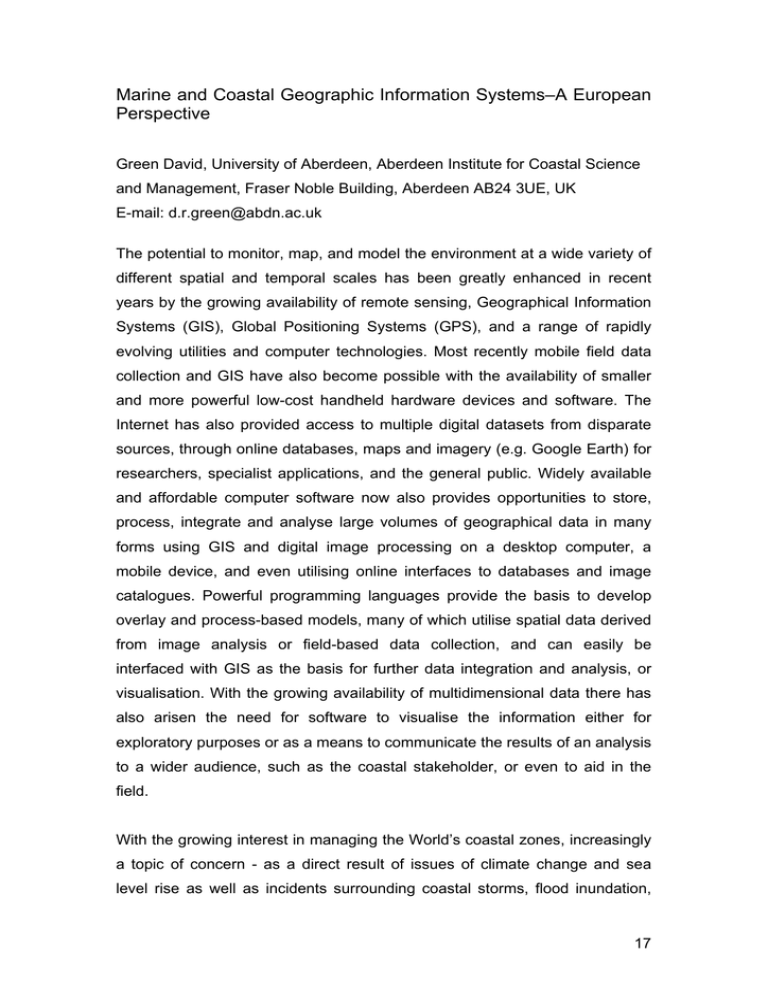Marine and Coastal Geographic Information Systems–A European Perspective
advertisement

Marine and Coastal Geographic Information Systems–A European Perspective Green David, University of Aberdeen, Aberdeen Institute for Coastal Science and Management, Fraser Noble Building, Aberdeen AB24 3UE, UK E-mail: d.r.green@abdn.ac.uk The potential to monitor, map, and model the environment at a wide variety of different spatial and temporal scales has been greatly enhanced in recent years by the growing availability of remote sensing, Geographical Information Systems (GIS), Global Positioning Systems (GPS), and a range of rapidly evolving utilities and computer technologies. Most recently mobile field data collection and GIS have also become possible with the availability of smaller and more powerful low-cost handheld hardware devices and software. The Internet has also provided access to multiple digital datasets from disparate sources, through online databases, maps and imagery (e.g. Google Earth) for researchers, specialist applications, and the general public. Widely available and affordable computer software now also provides opportunities to store, process, integrate and analyse large volumes of geographical data in many forms using GIS and digital image processing on a desktop computer, a mobile device, and even utilising online interfaces to databases and image catalogues. Powerful programming languages provide the basis to develop overlay and process-based models, many of which utilise spatial data derived from image analysis or field-based data collection, and can easily be interfaced with GIS as the basis for further data integration and analysis, or visualisation. With the growing availability of multidimensional data there has also arisen the need for software to visualise the information either for exploratory purposes or as a means to communicate the results of an analysis to a wider audience, such as the coastal stakeholder, or even to aid in the field. With the growing interest in managing the World’s coastal zones, increasingly a topic of concern - as a direct result of issues of climate change and sea level rise as well as incidents surrounding coastal storms, flood inundation, 17 and coastal disasters resulting from hurricanes and tsunami - the geospatial technologies are finding an increasing number of practical applications. These range from research-based academic studies to develop our knowledge and understanding of coastal processes, to essential environmental monitoring exercises, accessibility to data and information and stakeholder involvement and participation in coastal management problems, particularly where there is a need for a range of practical tools. Around the World an increasing amount of time and money is now also being invested in studying the coastal environment, much of it through projects that seek to bring together the scientific community, the policy maker, and the public to facilitate sustainable management of the coastal zone. Whilst such technologies have largely been the domain of the specialist in the past, these are now becoming more widely available and more useful to a greater range of people from the researcher to the practitioner. Remote sensing has also long provided a means to gather current environmental data and information about the coast, often using airborne cameras e.g. aerial photography, but with renewed interest more recently using specialist airborne sensors such as the CASI and Lidar, the latter offering both terrestrial heighting and underwater capability for bathymetry. Numerous acoustic sensors also provide remote sensing capabilities at greater depths. Satellite remote sensing offers numerous additional and already well known capabilities such as synoptic coverage and repeatability. However, increasingly better spatial, spectral, and temporal resolutions are also yielding new sources of information. This presentation seeks to provide a brief snapshot of some of the developments surrounding the growing use of the geospatial technologies in the spatial and temporal study and management of coastal environments. Although it can only offer a very brief insight into the many different ways in which a wide range of geospatial technologies have been and are being used, it will touch upon some of the most important areas of current developments and uses, offering insight into the importance of data and information as a 18 means to help gain a better knowledge and understanding of coastal environment, the interface between the land and the sea and the goal of sustainable and integrated coastal zone management (ICZM). The presentation will be illustrated with a number of examples. 19







